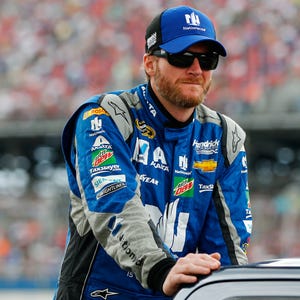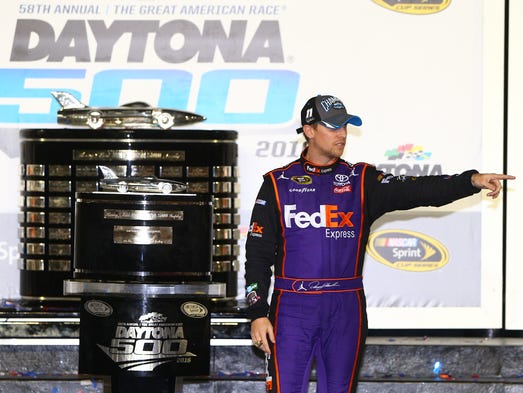NASCAR drivers dismayed, dumbfounded by Talladega crashfest – USA TODAY
TALLADEGA, Ala. — Trevor Bayne, drenched in sweat with beads of perspiration clinging to his forehead, wandered off pit road after Sunday’s Talladega Superspeedway race and smiled.
His No. 6 car was untouched, but it was one of only a handful that survived a demolition derby of a race that saw 35 of the 40 cars leave with at least some damage.
“It’s very insane,” Bayne said of Talladega racing. “You get butterflies in your stomach even thinking about coming here because you don’t know what’s going to happen. Even (the last restart) we’re sitting third and I’m like, ‘Well, we could win or we could end up on a wrecker with the roof torn off.’”
If it’s possible, Talladega was even crazier than usual. And that’s saying a lot for a place race winner Brad Keselowski called a “daredevil track.”
Matt Kenseth got airborne and looked for a moment as if he’d sail into the infield. Chris Buescher flipped and barrel-rolled down the backstretch. And Kevin Harvick finished 15th despite spending the end of the race riding the top of the SAFER barrier, roof-first, right in front of where many fans were craning their necks in the stands and trying to see the finish.
There were several other incredibly hard hits as well, and NASCAR was fortunate everyone walked away. But drivers know it might not always end up that way.
“You can’t (have cars go airborne) but so many times before we need to realize something (needs to change),” Austin Dillon said. “We need to jump on this and try to get it before the next couple speedways in order to keep them on the ground.”
Dillon suggested slowing the cars down would be the best solution, but most drivers who said flying cars were a problem didn’t know how to fix it.
“I don’t know if really anyone in our sport knows the answer,” Keselowski said.
So will anything really change in the next two months? That’s the time remaining before NASCAR makes a return to the scene of Dillon’s vicious crash into the fence last year at Daytona International Speedway, which left five fans with minor injuries.
NASCAR has been pack-racing at Talladega and Daytona for decades now and crash-filled races like Sunday’s still happen.
“What are you going to do?” Kyle Busch said. “Keep going. That’s it. It’s been that way for 30 years.”
PHOTOS: All the crashes in Sunday’s GEICO 500
Drivers realize there’s a difficult balance between entertainment and safety. At Talladega, though, the seesaw between the two can be dramatic.
One moment, the drivers are racing in a thrilling, four-wide pack; the next, they might be careening toward a collision with the fence that could mean serious injury or worse. And it’s not just drivers who are at risk, but fans.
NASCAR did not have anyone available to comment on Sunday’s race, but Talladega will once again generate much discussion over the next week.
“It’s just hold it wide open before you crash,” Danica Patrick said after a fierce crash. “Even if think you’re going to wreck, you hold it wide open. It’s just dangerous, but it’s exciting. I understand that. I enjoy watching it, too.”
But given the chaos is more likely to take place at Talladega and Daytona than a normal track, is it still even worth racing at these risk-filled venues?
Keselowski paused for a moment, then chuckled.
“Hey, I’m a capitalist,” he said. “There are people still paying to sit in the stands and there are sponsors still on the cars. There are drivers still willing to get in them.
“It sounds like it’s self-policing and there’s enough interest to keep going. So we’ll keep going.”
Follow Gluck on Twitter @jeff_gluck
PHOTOS: 2016 Sprint Cup race winners

































